#Water of Tripura
Photo

Neermahal, Rudijala, Melaghar, Tripura, India
#art#design#architecture#palace#india#neermahal#royal#royal palace#tripura#lake#melaghar#luxurylifestyle#luxuryhomes#luxuryhouses#style#history#rudrasagar#water palace#summer palace#rudijala
204 notes
·
View notes
Text
The International Conference on Dam Safety (ICDS) was organized by the Department of Water Resources, River Development & Ganga Rejuvenation, Ministry of Jal Shakti at the Rajasthan International Centre (RIC) in Jaipur on September 14-15.
#Central Water Commission#Central Water Commission India#Chief Minister of Tripura DK Shivakumar#Chief Secretary#Dam Safety#Dam Safety Management#Gajendra Singh Shekhawa#tGajendra Singh Shekhawat Union Minister of Jal Shakti#Goa#Government of Rajasthan#ICDSICDS2023#IISC Bengaluru#IIT Roorkee#International Conference on Dam Safety#International Conference on Dam Safety Jaipur#Jal Shakti#Karnataka#Mahendrajeet Singh Malviya#Manipur#Minister of Water Resources#Ministry of Jal Shakti#Ministers from Tripura#MNIT Jaipur#Pankaj Kumar Secretary Ministry of Jal Shakti#Rajasthan#Rajasthan and Pankaj Kumar#Saroj Kr Jha#Secretary#UPUsha Sharma#Vice President Dhankha
0 notes
Text
The Remarkable Benefits of a Iron Removal Plant : Dewpure
One of the remarkable benefits of a iron removal plant is its ability to eliminate the building up of sediment in the water. This particular type of filtration system will provide the highest quality of water for consumption.

#iron removal plant in Arunachal Pradesh#water iron removal filter in Arunachal Pradesh#iron removal plant in Tripura#water iron removal filter in Tripura#iron removal plant in Assam#water iron removal filter in Assam
0 notes
Text
NAKSHATRAS AS GODDESSES
3/27
🔪KRITTIKA🔥
DISCLAIMER: This is based solely on my research and the patterns that I saw. I can't promise that I'm gonna be sure in all the coorelations, but I'm going to attribute each nakshatra a goddess that I think fits it the closest. If you're dissapointed, to make up for it, I'm going to list some other deities in the end that I think also fit the nakshatra. Don't come for me if you think I'm wrong, be respectful in the comments if you think so and have fun 🤍
This was easy and almost immidiate. The associations between this goddess and Krittika are so apparent I didn't hesitate for a second. Look out for other deities similar to her in the end.
Brigid
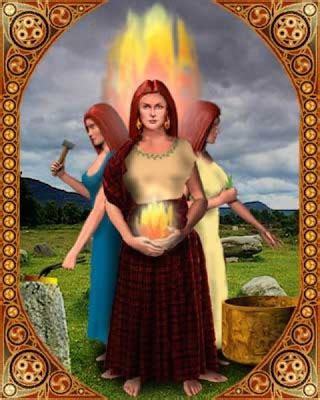
Pantheon: Celtic (Irish)
Name meaning: "the exalted one", "strength"
Associations: fire, spring, poetry and inspiration, healing and herbalism, smithcraft, agriculture, cattle and sheep.
Symbols: Brigid's cross, holy wells, eternal flame.
Brigid is one of the most highly- revered and widely worshipped Celtic goddesses. She'a triple goddess, representing the maiden, the mother and the crone. As a Maiden, she rules over poetry, music and ispiration. As a Mother, she's presiding over healing. As a Crone, she's the goddess of fire and smithcraft.
Frequently depicted with fiery red hair, she is no simple goddess, also ruling over waters and serenity. She's a protector of women and children, presiding over childbirth and motherhood. Also frequengly depicted with lambs and sheep (krittika's yoni animal) and swans. She's closely connected to agriculture and farm animals.
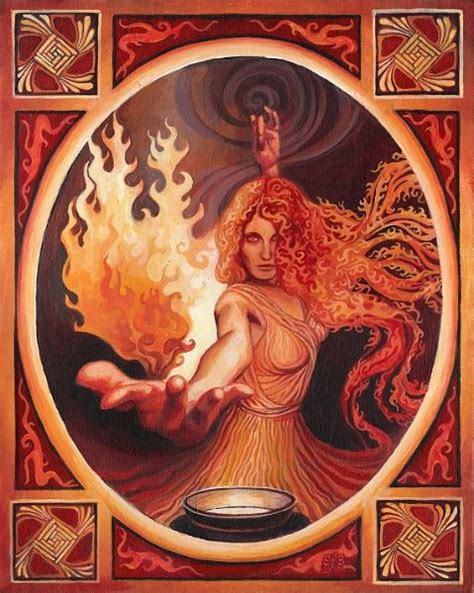
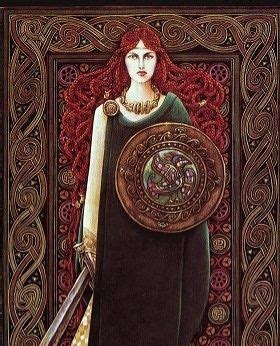
Brigid, also being connected to wells and rivers, has many landmarks in Ireland with a body of water. The most famous one is a well in Kildare, Ireland. Water from that well is said to have healing properties.
Her father was Dagda (good, great god), leader of the Irish tribe Tuatha Dé Danann ("people of goddess Danu"), which consisted of Irish deities who lived there before the ancestors of the modern Irish had arrived. Dagda was a wise man, an all-father and a Druid. Brigid married Bres, another member of that tribe and together they had three children. One of them, Ruadán, died and Brigid mourned him with profound and painful sadness. She's very devoted to protecting children and this might be a reason why.


In honor of her, there's a sacred fire lit in Kildare and is guarded by the Sisters of St. Brigid. There has been a fire in Kildare since the time Brigid was worshipped. It has been put out several times, but has been re-lit and is still burning. This suggests that the worship of Brigid has endured as she she survived and was made a Catholic saint when Christianity came to Europe.

I want to talk about why I chose her for Krittika while comparing her to very similar goddesses.
First one is the Roman Vesta. Virgins were chosen to keep the fire of vesta burning and it was said that if even one of them gave their virginity, the fire would burn out. In those instances when fire burned out by itself, the poor Vestal Virgins were to blame. Vesta is also the Roman Equivalent of the Greek Hestia, both being goddesses of the hearth, fire and home.
Krittika is the nakshatra that burns impurities through being precise and cutting away all that is not nessecary, hence a sharp object and a flame being its symbols. Bridging the signs of Aries and Taurus, it's often fiery and passionate but also feminine and nurturing.
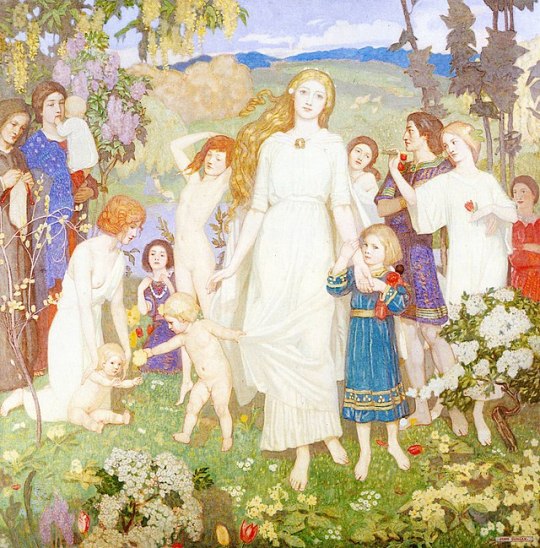
An Indian deity ruling over Krittika is Agni_ God of fire. An Indian goddess that is coorelated to Krittika (and also Purva Phalguni) is Tripura Sundari, meaning "the most beautiful in three worlds". This three world- triple goddess coorelation is apparent to me, besides the obvious fire associations, as well as nurturing, fertility and agriculture.
In the lunar mansion of Krittika, there's a constellation called the Pleiades, often called "the seven sisters". This is another confirmation of Krittika's very feminine nature, despite also representing the birth of the cosmic man and being very fiery and passionate in general.
Some other deities that I'd coorelate with Krittika:
Hestia- another virginal goddess of fire, also associated with home and hearth
Tripura Sundari- Indian goddess, "the most beautiful in the worlds"
Vesta- Roman goddess of fire and virgins
Bel- Celtic sun and fire god, also associated with healing, thunder and purification.
That's it! I hope you enjoyed reading about Brigid. This is a very condensed post but I said pretty much everything I wanted to say. I hope you understood Brigid's energy and made the coorelation between her and Krittika. If you're Krittika, even if you're not, COMMENT, like and reblog. Love u, take care ❤🔥
#krittika#krittika nakshatra#nakshatras#vedic astrology#astrology#astrology observations#vedic astrology observations#brigid#celtic mythology#irish mythology#ireland#celtic#goddess#goddess brigid
124 notes
·
View notes
Text
A walk through Bengal's architecture
Bengali architecture has a long and rich history, fusing indigenous elements from the Indian subcontinent with influences from other areas of the world. Present-day Bengal architecture includes the nation of Bangladesh as well as the Indian states of West Bengal, Tripura, and Assam's Barak Valley. West Bengal’s architecture is an amalgamation of ancient urban architecture, religious architecture, rural vernacular architecture, colonial townhouses and country houses, and modern urban styles. Bengal architecture is the architecture of Wind, Water, and Clay. The Pala Empire (750–1120), which was founded in Bengal and was the final Buddhist imperial force on the Indian subcontinent, saw the apex of ancient Bengali architecture. The majority of donations went to Buddhist stupas, temples, and viharas. Southeast Asian and Tibetan architecture was influenced by Pala architecture. The Grand Vihara of Somapura, which is now a UNESCO World Heritage Site, was the most well-known structure erected by the Pala rulers.

The Grand Vihara of Somapura
According to historians, the builders of Angkor Wat in Cambodia may have taken inspiration from Somapura. Bengal architecture became known for its use of terracotta due to the scarcity of stone in the area. Clay from the Bengal Delta was used to make bricks.
The temple architecture has distinct features like the rich wall decoration, often known as the terracotta temples, which was one of the remarkable elements of Bengali temple architecture. The double-roofed architecture of thatched huts was replicated by Bengali temples. Square platforms were used to construct the temples. Burnt brick panels with figures in geometric patterns or substantial sculptural compositions served as the temples' adornment.

Dochala style
These served as models for many temples that were built in undivided Bengal. Construction materials used in ancient times included wood and bamboo. Bengal has alluvial soil, so there isn't a lot of stone there. The bricks that were utilized to build the architectural components were made from stone, wood, black salt, and granite. Bengal has two different types of temples: the Rekha type, which is smooth or ridged curvilinear, and the Bhadra form, which has horizontal tiers that gradually get smaller and is made up of the amalaka sila. Mughal architecture, including forts, havelis, gardens, caravanserais, hammams, and fountains, spread throughout the area during the Mughal era in Bengal. Mosques built by the Mughals in Bengal also took on a distinctive regional look. The two major centers of Mughal architecture were Dhaka and Murshidabad. The do-chala roof custom from North India was imitated by the Mughals.

Jorasako thakurbari
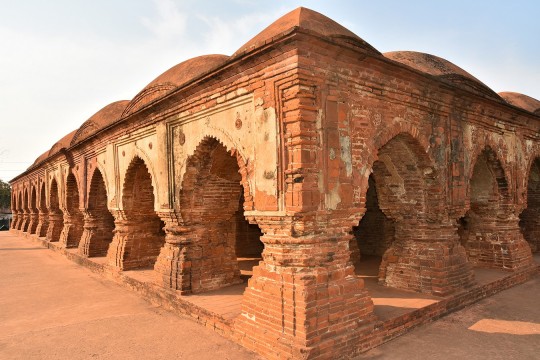
The Rasmancha is a heritage building located at Bishnupur, Bankura district, West Bengal.
Influence of the world on Bengal architecture: Although the Indo-Saracenic architectural style predominated in the area, Neo-Classical buildings from Europe were also present, particularly in or close to trading centers. While the majority of country estates had a stately country house, Calcutta, Dacca, Panam, and Chittagong all had extensive 19th and early 20th-century urban architecture that was equivalent to that of London, Sydney, or other British Empire towns. Calcutta experienced the onset of art deco in the 1930s. Indo-Saracenic architecture can be seen in Ahsan Manzil and Curzon Hall in Dhaka, Chittagong Court Building in Chittagong, and Hazarduari Palace in Murshidabad.
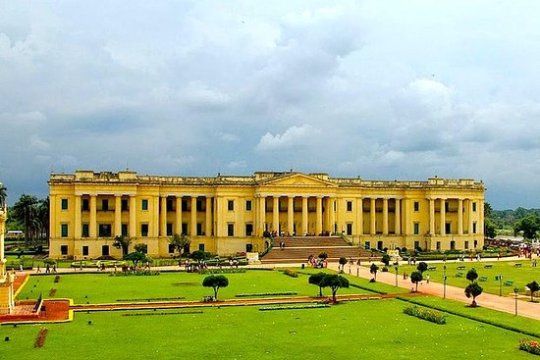
Hazarduari Palace in Murshidabad
The Victoria Memorial in Kolkata, designed by Vincent Esch also has Indo-Saracenic features, possibly inspired by the Taj Mahal. Additionally, Kolkata's bungalows, which are being demolished to make way for high-rise structures, have elements of art deco. The 1950s in Chittagong saw a continuation of Art Deco influences. The Bengali modernist movement, spearheaded by Muzharul Islam, was centered in East Pakistan. In the 1960s, many well-known international architects, such as Louis Kahn, Richard Neutra, Stanley Tigerman, Paul Rudolph, Robert Boughey, and Konstantinos Doxiadis, worked in the area.

The Jatiyo Sangshad Bhaban
This iconic piece of contemporary Bangladeshi architecture, was created by Louis Kahn. Midsized skyscrapers dominate the cityscapes of contemporary Bengali cities, which are frequently referred to as "concrete jungles." With well-known architects like Rafiq Azam, architecture services play a key role in the urban economies of the area. Overall Bengal architecture was influenced by various contemporaries of their time and continues to evolve.

Gothic architectural style seen in St. Paul's Cathedral in Kolkata.

Zamindar era buildings in ruin.

Belur Math in Howrah
#bengali#bangla#west bengal#bangladesh#tripura#assam#desi#বাংলা#india#architecture#tales#bengal architecture#history#kolkata#international#technology#information#temple#asia#bricks
171 notes
·
View notes
Text
Sahaja Yoga Meditation
What is SAHAJA YOGA MEDITATION?
"Sahaja yoga meditation" define as inner spiritual growth as well as good health.
It filled with peace ,relaxation ,patience , and so on .
Most importantly ,"Sahaja yoga meditation " is famous all over the world .
Similarly ,it work with different source of medium for all individual.
Above all , availability of lots of video ,post, books and so on.
On the other hand ,they have lots of yoga videos .
lacking information available for all individual.
It connect with urban and rural people.
Benefits of "SAHAJA YOGA MEDITATION":-
True meditation and yoga provide lacking benefits for our health.
Firstly ,Early morning meditation with yoga gives healthy body .
Secondly ,It avoid illness.
Most importantly ,remove health issues problem from the body.
Proper functioning all body parts.
However ,it fulfill all requirement for healthy body .
Right meditation provide knowledgeable as well as sharpen mind.
On the other hand , increase thinking power.
However ,filled with positive mind avoid negative thoughts.
Above all ,it increase immunity power Reduces stress and weakness.
Moreover ,Give fruitful wisdom and also reduces sickness in body.
It provide fruitful wisdom for proper body growth.
"Sahaja yoga meditation" Centre in India:
Uttarakhand
West Bengal
Uttar Pradesh
Tripura
Telangana
Tamil Naidu
Sikkim
Rajasthan
Punjab
Nagaland
Odisha
Pondicherry
Manipur
Meghalaya
Mizoram
Kerala
Madhya Pradesh
Maharashtra
Jammu Kashmir
Jharkhand
Karnataka
Gujrat
Haryana
Himachal Pradesh
Daman and Diu
Delhi
Goa
Assam
Bihar
Chhattisgarh
Andaman Nicobar
Andhra Pradesh
Arunachal Pradesh
Sahaja yoga meditation steps:-
There are different steps are as follows:-
Firstly ,sit straight with relax mind.
close eyes and than ,create silence with your inner soul.
After that ,meditate with right concentration.
Good diet for good heath:-
Fresh air also a part of good health.
Similarly , eat fresh vegetables and fruits.
proper yoga and meditation.
On the other hand ,drink more and more water.
Most importantly ,avoid junk food.
In other words ,its harmful .
Else while ,take proper sleep.
Consequently ,use good oil for cooking.
Proper functioning digestive system.
Above all ,Good diet remove tiredness.
Meditation and yoga is important for good health and Most importantly, for proper functioning digestives system . Moreover ,drink more and more water and live life joyful.
#Sahaja Yoga Meditation#Meditation and Yoga#drink more and more water#proper functioning digestive system
2 notes
·
View notes
Text
Book of demons guide

Nixie, a freshwater femme fatale amphibian from Teutonic lore. Some demonic entities and spirits that intrigued me were:ġ. Each entry discussed the basics of the creature/demon/spirit and explained the lore surrounding them. All the demonic spirits come from various occult texts, epic legends, myths, folklore, and superstitions throughout various cultures. More interestingly there were two distinct chapters that discussed demons found in the home and demons that terrorize people's psyches. The chapters are categorized by locations of where these subversive beings are found: bodies of water, forests, deserts, and mountains. It focused on demons, fairies, fallen angels, and other malevolent entities from around the world. It is basic and isn't a scholarly work by any means. All the demonic spirits come from vario This was a fun and interesting read. Perfect for the armchair traveler and the intrepid, seasoned demon-spotter alike, this complete guide to subversive spirits offers a behind-the-scenes look at the devilish mishaps, impish irritations, and demonic devastations that punctuate our lives.more Packed with lore about each demon, detailing its origins, the culture surrounding it, and its reputed antics and exploits, A Field Guide to Demons, Fairies, Fallen Angels, and Other Subversive Spirits is a fascinating exploration of global mythologies. This illustrated guide-the first of its kind-reveals the remarkable permutations of the demon and fairy species worldwide. And, to the uninformed, they are often invisible. They are powerful they are protean they are enchanting. They lurk at crossroads, crouch behind doors, hide in trees, slip into beds, wait in caves, hover at weddings and childbirths, disguise themselves as friends, relatives-even disguise themselves as you. And what to do next.ĭemons, fairies, and fallen angels are everywhere. How to spot and identify demons and other subversive spirits. Demons, fairies, and fallen angels are everywhere. Blending insightful erudition and lively description, Nanditha Krishna brings to life the traits and actions of a host of complex, colourful, monstrous and intriguing demons that inhabit Indian religion and mythology.Watch your back!. Male or female, human, animal, plant, or simply a concept?"demons play a pivotal role in our mythical traditions. Andhaka (blind darkness), conceived when Parvati playfully covered Shiva's eyes and the world was plunged into darkness Gajamukha, the elephant-faced demon who was transformed into a mouse by Ganesha and then converted into his vehicle Jambha, the demon-leader who snatched the pot of immortal nectar from the ocean during the great churning Maya, the demonic equivalent of Vishvakarma, architect of the gods, who built the three cities of Tripura and Putana, the demon who tried to kill Krishna by suckling him with poisoned breasts. Besides the well-known rakshasas and asuras, the author also reveals a densely populated world of lesser-known, but equally fascinating, demonic creatures. The Book of Demons presents a perceptive overview of the various types of demonic beings and concepts that exist in Hindu literature, supplemented with a dictionary of individual demons for ready reference. Time and again, the menacing and uncontrollable forces of night, darkness and death, along with powerful defeated enemies and incomprehensible natural phenomena, are demonized. From the Rig Veda to myriads of folk narratives, the belief in demons prevails all over India, vividly illustrating that a demon is something people fear because it is beyond their comprehension and control.

2 notes
·
View notes
Text
Best Tourist Attractions in North East Indian
Best Tourist Attractions in North East Indian
North east India is full of natural beauty. It is also known as seven sisters which consists of Arunachal Pradesh, Assam, Manipur, Meghalaya, Mizoram, Nagaland, and Tripura. It is full of natural beauty, adventure & soulful places. If you are having a passion to explore the beauty of nature then a person must explore North East India. It is full of dense forest, clean blue water fall & mountains…

View On WordPress
4 notes
·
View notes
Text
Six Head Bottle Capping Machine

Company Overview:
Shiv Shakti Machtech is a Manufacturer, Exporter, and Supplier of Six Head Bottle Capping Machine in Ahmedabad, Gujarat, India.
A six-head bottle capping machine is specialized equipment utilized in the packaging industry for efficient bottle capping.
It automatically caps bottles with caps or closures, commonly made of plastic or metal materials.
The machine is equipped with six capping heads, allowing for simultaneous capping and enhancing production efficiency.
Also known as Rotary Six Head Bottle Capper Machine, Rotary Six Head Chuck Capper machine, and Rotary Bottle Capper Machine.
Salient Features:
No bottle, no cap system.
Made of stainless steel for durability and hygiene.
Minimal changeover and setting time, ensuring time effectiveness.
Easy dismantling of parts for cleaning.
Equipped with safety features like a Clutch System to prevent glass breakage.
User-friendly main operating panel for easy operation.
Applications:
Beverage Industry: Capping bottles of water, soft drinks, juices, and other beverages.
Pharmaceutical Industry: Capping bottles containing medications, supplements, and pharmaceutical products.
Cosmetics Industry: Capping bottles of lotions, creams, shampoos, and other cosmetic products.
Food Industry: Capping bottles of sauces, dressings, condiments, and edible oils.
Geographical Coverage:
Shiv Shakti Machtech serves Six Head Bottle Capping Machines in Ahmedabad, Gujarat, India, and across various states and territories including Andhra Pradesh, Arunachal Pradesh, Assam, Bihar, Chandigarh, Chhattisgarh, Dadra and Nagar Haveli and Daman and Diu, Delhi, Goa, Gujarat, Haryana, Himachal Pradesh, Jammu and Kashmir, Jharkhand, Karnataka, Kerala, Ladakh, Madhya Pradesh, Maharashtra, Manipur, Meghalaya, Nagaland, Odisha, Puducherry, Punjab, Rajasthan, Sikkim, Tamil Nadu, Telangana, Tripura, Uttar Pradesh, Uttarakhand, and West Bengal.
Interested parties can contact Shiv Shakti Machtech for further details and inquiries.
Read the full article
#Ahmedabad#AndhraPradesh#ArunachalPradesh#Assam#Bihar#Chandigarh#Chhattisgarh#DadraandNagarHaveliandDamanandDiu#Delhi#Exporter#ExporterofSixHeadBottleCappingMachine#Goa#Gujarat#Haryana#HimachalPradesh#India#JammuandKashmir#Jharkhand#Karnataka#Kerala#Ladakh#MadhyaPradesh#Maharashtra#Manipur#Manufacturer#Meghalaya#Nagaland#Odisha#Puducherry#Punjab
0 notes
Text
Tripura is a very popular tourist destination. This state, located at the foothills of the Himalayan mountains in northeast India, is famous for its rich cultural heritage.
The main tourist attractions in #Tripura are sites of historical value. The most prominent among them is the Ujjayanta Palace, a picturesque white structure in the heart of the state capital, Agartala.
No less majestic in its architecture is Neermahal, whose name means “water palace”. Many migratory birds flock to the lake adjacent to this architectural monument. Water sports are available here and a boat festival is held in July-August.
Tripura also features many temples, some of which were built thousands of years ago and are still famous for their traditions.
The state will not disappoint wildlife lovers either, as it is home to large nature reserves and national parks. The most famous of these is the Sepahijala Wildlife Sanctuary, which is home to an impressive variety of flora and fauna.
#IncredibleIndia



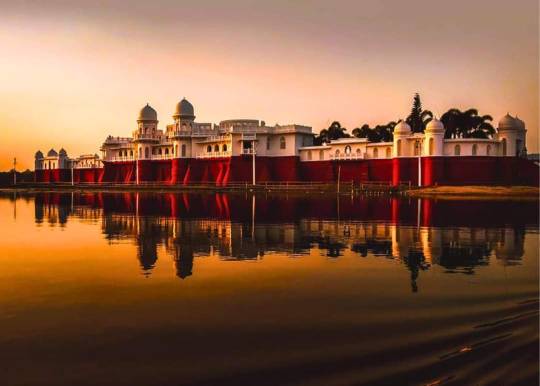



0 notes
Text
Holidays 4.14
Holidays
Air Force Reserve Day
American Dictionary Day
Americas Day (Honduras, Mexico)
Anfal Genocide Memorial Day
Black Day (South Korea)
Blessing of the Salmon Nets (Northumbria)
Bon Jovi Day (New Jersey)
Cake and Cunnilingus Day
Children’s Day (Peru)
Children with Alopecia Day
Commemoration of Anfal Genocide Against the Kurds (Iraqi Kurdistan)
Cuckoo Day (Old England)
Day of Mologa (Russia)
Day of (No) Silence (GLSEN)
Day of the Georgian Language
Day of the Skater
Dhivehi Language Day (Maldives)
Dictionary Day
Donate Life Blue & Green Day
Draw MegaMan Day
Dreams of Reason Feast Day
Ex-Spouse's Day
414 Day
Global Roller Day
Grand National Ladies Day (UK)
Gujarat (Fire Service Day; India)
International Goalkeeper Day
International Moment of Laughter Day
International Silambam Day
Kids’ Yoga Day
Kinetoscope Day
Look Up at the Sky Day
Lundkommardagen (Puffin Arrival Day; Norway)
Meme Appreciation Day
Milwaukee Day (414)
Moirang Day (a.k.a. Victory Day; India)
National Bracelet Day
National Dolphin Day
National Donate a Book Day
National Gardening Day
National Kick Balls Day
National Love Our Children Day
National Not Ashamed of Jesus Day
National Perfume Day
National Reach as High as You Can Day
N'Ko Alphabet Day (Mande)
Orange Day (Japan)
Pan American Day
Pathologists’ Assistant Day
Peregrine Falcon Appreciation Day
Peter Capaldi Day
Pigeon Day (French Republic)
Reach As High As You Can Day
Samjinnal (Arrival of Spring; Korea)
Secret Service Day
Spring Hula Hooping Day
Tempting Fate Day
Takayama Spring Festival (Japan)
Thingyan begins (Water Festival; Burma)
Winnie Madikizela-Mandela Day of Service (South Africa)
World Chagas Day
World Quantum Day
Youth Day (Angola)
Food & Drink Celebrations
Espresso Italiano Day (Italy)
International Laverbread Day
Laverbread Day
National Grits Day
National Pecan Day
Oreo Cookie Cheesecake Day
Saison Day
Tannat Day (Uruguay)
2nd Sunday in April
Air Defense Forces Day (Belarus, Russia) [2nd Sunda
Global Day to End Sexual Abuse [2nd Sunday]
Weekly Holidays beginning April 14 (3rd Week)
Animal Control Appreciation Week [2nd Full Week in April]
Animal Cruelty/Human Violence Awareness Week Week [3rd Week in April]
Astronomy Week — Spring [thru 4.20]
Cleaning For A Reason Week [begins 2nd Sunday]
National Coin Week [3rd Week in April]
National Dog Bite Prevention Week [3rd Week in April]
National Public Safety Telecommunications Week [2nd Full Week in April]
National Student Employment Week [2nd Full Week in April]
National Volunteer Week Week [3rd Week in April]
Neurodiagnostic Week [3rd Week in April]
Organize Your Files Week Week [3rd Week in April]
Pan American Week [Week of 4.14]
Independence & Related Days
Jonja Island (Declared; 2022) [unrecognized]
Lawfords (a.k.a. Kingdom of Lawfords; Declared; 2021) [unrecognized]
New Year’s Days
Hindi New Year (a.k.a. …
Assamese New Year
Baisakhi (Parts of India)
Bisket Jatra (Nepali New Year)
Bohag Bihu (Assam Valley)
Cambodian New Year
Chetti Chand (Parts of India)
Guḍhī Pāḍavā [1st Day of Chaitra]
Hari Raya Yep Tahun Baru (Indonesia)
Malayali New Year (Kerala)
Nyepi Day (a.k.a. Day of Silence; Bali)
Ougadi (Mauritius)
Pi Mai (Laotian New Year)
Ramayana begins
Sajibu Nongmapanba (Cheiraoba, Manipur, India)
Telgu New Year
Thingyan begins (Burma)
Ugadi (Parts of India)
Vaisakhi (Parts of India)
Kerala New Yea (India)
New Year's Day (Assamese, Bengali, Burmese, Sikh, Khmer, Lao, Nepali, Oriya, Sinhalese, Tamil, Thai, Tuluva; Southeast Asia) [Sidereal Vernal Equinox]
Sidereal New Year (South and Southeast Asian) (a.k.a. …
Aluth Avurudda (Sri Lanka)
Biju Festival (Parts of India)
Bisu (Tulu Nadu region of Karnataka and Kerala, India)
Bizhu (Chakmas in Mizoram, Tripura and Bangladesh)
Bohag Bihu (Assam, India)
Buisu (Tripura, India)
Bwisagu (Bodoland region of Assam, India)
Cheiraoba (Parts of India)
Choul Chnam Thmey (Cambodia)
Jur Sital (Mithila region of Bihar, India and Nepal)
Khmer New Year (Cambodia)
Maha Vusubha Sankranti (Parts of India)
Oriya New Year (Parts of India)
Pahela Baishakh (Bangladesh and West Bengal, India)
Pana Sankranti (Odisha, India)
Pi Mai (Laos)
Puthandu (Tamil Nadu and Puducherry, India and Northern and Eastern regions of Sri Lanka)
Rongali Bihu (Parts of India)
Samjinnal (Korea)
Sangken (Khamti, Singpho, Khamyang, Tangsa in Arunachal Pradesh and Tai Phake, Tai Aiton, and Turung in Assam, India)
Sinhala (Sri Lanka)
Songkran (Thailand)
Tamil New Year (Parts of India)
Thingyan (Myanmar)
Tuluva New Year (Parts of India)
Vaisakhi (Punjab, North and Central India, Nepalese New Year in Nepal)
Varusha Pirruppa (Tamil New Year; Mauritius)
Vishu (Kerala, India)
Water-Sprinkling Festival (Yunnan, China)
Festivals Beginning April 14, 2024
Alphretta Wine Festival (Alpharetta, Georgia)
The Chocolate Expo (Long Island, New York)
International Rose & Wine Festival (Shreveport, Louisiana)
New Haven Restaurant Week (New Haven, Connecticut) [thru 4.19]
Ocean City Restaurant Week (Ocean City, Maryland) [thru 4.19]
Seville Fair (Seville, Spain) [thru 4.20]
Vinitaly (Verona, Italy) [thru 4.17]
ZagreDox (Zagreb, Croatia) [thru 4.21]
Zilker Kite Festival (Austin, Texas)
Feast Days
Abushibarei (Ryukyuan)
Adolph Hitler Day (Church of the SubGenius; Saint)
Albategnius (Positivist; Saint)
Ambedkar Jayanti (India)
Ardalion (Christian; Martyrs)
Bénézet (Christian; Saint)
Bernard of iron (Christian; Saint)
Caradoc, Benezet, John, Antony and Eustace (Christian; Martyrs)
Carpus of Thyatira (Christian; Saint)
Domnina of Terni (Christian; Saint)
Elfin Choirs Congress (Shamanism)
The Extremes (Muppetism)
Gabriel Jacques de Saint-Aubin (Artology)
Galungan (Celebrating Victory of Dharma over Adharma; Bali)
Henry Beard Delany (Episcopal Church (USA))
Justin (Christian; Martyr)
Lambert of Lyons (Christian; Saint)
Lidwina (a.k.a. B. Lidwina of Schiedam or Lydwina; Christian; Saint)
Look Up at the Sky Day (Pastafarian)
Marianne’s Day (Pagan)
Maryamma (Goddess of the Sea; Hinduism; Everyday Wicca)
Peter González (Christian; Saint)
Sommarsblot (Norse)
Three Smiles Day (Celtic Book of Days)
Tiburtius, Valerian, and Maximus (Christian; Martyrs)
Victor Borisov-Musatov (Artology)
Islamic Moveable Calendar Holidays
Eid al-Fitr celebrations continue (Islam)
Lucky & Unlucky Days
Historically Bad Day (Lincoln shot, Titanic hit an iceberg & 9 other tragedies) [1 of 11]
Tomobiki (友引 Japan) [Good luck all day, except at noon.]
Umu Limnu (Evil Day; Babylonian Calendar; 17 of 60)
Premieres
About Damn Time, by Lizzo (Song; 2022)
American Psycho (Film; 2000)
Batman vs. Robin (WB Animated Film; 2015)
Beach Blanket Bingo (Film; 1965)
Beauty and the Beast (WB MM Cartoon; 1934)
The Big Bad Wolf (Disney Silly Symphonies Cartoon; 1934)
British Steel, by Judas Priest (Album; 1980)
Buddy’s Garage (WB LT Cartoon; 1934)
Bye Bye Birdie (Broadway Musical; 1960)
The Candle in the Wind, by T.H. White (Novel; 1958) [Once and Future King #4]
Cannery Roden (Tom & Jerry Cartoon; 1967)
Diver Down, by Van Halen (Album; 1982)
Execution Dock, by Anne Perry (Novel; 2009)
The Fair-Haired Hare (WB LT Cartoon; 1951)
Farewell Waltz, by Milan Kundera (Novel; 1972)
The Fate of the Furious [F&F #8]
Girl Happy (Film; 1965)
Grape Nutty (Color Rhapsody Cartoon; 1949)
The Grapes of Wrath by John Steinbeck (Novel; 1939)
The Hash Shop (Oswald he Lucky Rabbit Cartoon; 1930)
The History of Sexuality, by Michel Foucault (Philosophy Book; 1976)
Iceland's Bell, by Halldór Laxness (Novel; 1943)
Insulin’ the Sultan (Ub Iwerks Cartoon; 1934)
The Invisible Man, by Ralph Ellison (Novel; 1952)
Iron Maiden, by Iron Maiden (Album; 1980)
It Takes a Nation of Millions to Hold Us Back, by Public Enemy (Album; 1988)
Keeping the Faith (Film; 2000)
The King of Torts, by John Grisham (Novel; 2003)
Kinky Boots (Film; 2006)
The Legend of Korea (Animated TV Series; 2012)
Let’s Dance, by David Bowie (Album; 1983)
The Missing Piece Shel Silverstein (Children’s Book; 1976)
Mixed Master (WB LT Cartoon; 1956)
Much Ado About Mousing (Tom & Jerry Cartoon; 1964)
The Notorious Bettie Page (Film; 2006)
Off the Deep End, by Weird Al Yankovic (Album; 1992)
The Pebble and the Penguin (Animated Film; 1995)
Put Me in the Zoo, by Robert Lopshire (Children’s Book; 1960)
Put-Put, Pink (Pink Panther Cartoon; 1968)
Renfield (Film; 2023)
Ripley’s Believe It or Not! (Radio Series; 1930)
Rocket Man, by Elton John (Song; 1972)
Say Anything (Film; 1989)
Shift: First Shift — Legacy, by Hugh Howey (Novel; 2012)
Spark (Animated Film; 2017)
Thank You For Smoking (Film; 2006)
Ultra, by Depeche Mode (Album; 1997)
Webster’s American Dictionary (Book; 1818)
The Wild (Animated Film; 2006)
Today’s Name Days
Elmo, Erna, Ernestine (Austria)
Maksim, Valerijan, Zdravko (Croatia)
Vincenc (Czech Republic)
Tiburtius (Denmark)
Lehe, Lehte, Lehti (Estonia)
Taito (Finland)
Ludivine, Maxime (France)
Elmo, Erna, Ernestine (Germany)
Aristarhos, Thomais (Greece)
Tibor (Hungary)
Abbondio, Ignazio, Lamberto (Italy)
Agape, Gudrite, Strauja (Latvia)
Justinas, Vaišvydė, Vaiva, Valerijonas, Visvaldas (Lithuania)
Ellinor, Nora (Norway)
Berenike, Julianna, Justyn, Maria, Myślimir, Tyburcjusz, Walerian, Waleriana (Poland)
Pahomie (Romania)
Maria (Russia)
Justína (Slovakia)
Lidia, Tiburcio, Valeriano (Spain)
Tiburtius (Sweden)
Martin (Ukraine)
Caradoc, Carey, Cary, Hudson (USA)
Today is Also…
Day of Year: Day 105 of 2024; 261 days remaining in the year
ISO: Day 7 of week 15 of 2024
Celtic Tree Calendar: Saille (Willow) [Day 1 of 28]
Chinese: Month 3 (Wu-Chen), Day 6 (Wu-Shen)
Chinese Year of the: Dragon 4722 (until January 29, 2025) [Wu-Chen]
Hebrew: 6 Nisan 5784
Islamic: 5 Shawwal 1445
J Cal: 15 Cyan; Oneday [15 of 30]
Julian: 1 April 2024
Moon: 38%: Waxing Crescent
Positivist: 21 Archimedes (4th Month) [Hippachus]
Runic Half Month: Man (Human Being) [Day 5 of 15]
Season: Spring (Day 27 of 92)
Week: 3rd Week of April
Zodiac: Aries (Day 25 of 31)
Calendar Changes
April (a.k.a. Aprilis; Julian Calendar) [Month 4 of 12]
Saille (Willow) [Celtic Tree Calendar; Month 4 of 13]
0 notes
Text
Holidays 4.14
Holidays
Air Force Reserve Day
American Dictionary Day
Americas Day (Honduras, Mexico)
Anfal Genocide Memorial Day
Black Day (South Korea)
Blessing of the Salmon Nets (Northumbria)
Bon Jovi Day (New Jersey)
Cake and Cunnilingus Day
Children’s Day (Peru)
Children with Alopecia Day
Commemoration of Anfal Genocide Against the Kurds (Iraqi Kurdistan)
Cuckoo Day (Old England)
Day of Mologa (Russia)
Day of (No) Silence (GLSEN)
Day of the Georgian Language
Day of the Skater
Dhivehi Language Day (Maldives)
Dictionary Day
Donate Life Blue & Green Day
Draw MegaMan Day
Dreams of Reason Feast Day
Ex-Spouse's Day
414 Day
Global Roller Day
Grand National Ladies Day (UK)
Gujarat (Fire Service Day; India)
International Goalkeeper Day
International Moment of Laughter Day
International Silambam Day
Kids’ Yoga Day
Kinetoscope Day
Look Up at the Sky Day
Lundkommardagen (Puffin Arrival Day; Norway)
Meme Appreciation Day
Milwaukee Day (414)
Moirang Day (a.k.a. Victory Day; India)
National Bracelet Day
National Dolphin Day
National Donate a Book Day
National Gardening Day
National Kick Balls Day
National Love Our Children Day
National Not Ashamed of Jesus Day
National Perfume Day
National Reach as High as You Can Day
N'Ko Alphabet Day (Mande)
Orange Day (Japan)
Pan American Day
Pathologists’ Assistant Day
Peregrine Falcon Appreciation Day
Peter Capaldi Day
Pigeon Day (French Republic)
Reach As High As You Can Day
Samjinnal (Arrival of Spring; Korea)
Secret Service Day
Spring Hula Hooping Day
Tempting Fate Day
Takayama Spring Festival (Japan)
Thingyan begins (Water Festival; Burma)
Winnie Madikizela-Mandela Day of Service (South Africa)
World Chagas Day
World Quantum Day
Youth Day (Angola)
Food & Drink Celebrations
Espresso Italiano Day (Italy)
International Laverbread Day
Laverbread Day
National Grits Day
National Pecan Day
Oreo Cookie Cheesecake Day
Saison Day
Tannat Day (Uruguay)
2nd Sunday in April
Air Defense Forces Day (Belarus, Russia) [2nd Sunda
Global Day to End Sexual Abuse [2nd Sunday]
Weekly Holidays beginning April 14 (3rd Week)
Animal Control Appreciation Week [2nd Full Week in April]
Animal Cruelty/Human Violence Awareness Week Week [3rd Week in April]
Astronomy Week — Spring [thru 4.20]
Cleaning For A Reason Week [begins 2nd Sunday]
National Coin Week [3rd Week in April]
National Dog Bite Prevention Week [3rd Week in April]
National Public Safety Telecommunications Week [2nd Full Week in April]
National Student Employment Week [2nd Full Week in April]
National Volunteer Week Week [3rd Week in April]
Neurodiagnostic Week [3rd Week in April]
Organize Your Files Week Week [3rd Week in April]
Pan American Week [Week of 4.14]
Independence & Related Days
Jonja Island (Declared; 2022) [unrecognized]
Lawfords (a.k.a. Kingdom of Lawfords; Declared; 2021) [unrecognized]
New Year’s Days
Hindi New Year (a.k.a. …
Assamese New Year
Baisakhi (Parts of India)
Bisket Jatra (Nepali New Year)
Bohag Bihu (Assam Valley)
Cambodian New Year
Chetti Chand (Parts of India)
Guḍhī Pāḍavā [1st Day of Chaitra]
Hari Raya Yep Tahun Baru (Indonesia)
Malayali New Year (Kerala)
Nyepi Day (a.k.a. Day of Silence; Bali)
Ougadi (Mauritius)
Pi Mai (Laotian New Year)
Ramayana begins
Sajibu Nongmapanba (Cheiraoba, Manipur, India)
Telgu New Year
Thingyan begins (Burma)
Ugadi (Parts of India)
Vaisakhi (Parts of India)
Kerala New Yea (India)
New Year's Day (Assamese, Bengali, Burmese, Sikh, Khmer, Lao, Nepali, Oriya, Sinhalese, Tamil, Thai, Tuluva; Southeast Asia) [Sidereal Vernal Equinox]
Sidereal New Year (South and Southeast Asian) (a.k.a. …
Aluth Avurudda (Sri Lanka)
Biju Festival (Parts of India)
Bisu (Tulu Nadu region of Karnataka and Kerala, India)
Bizhu (Chakmas in Mizoram, Tripura and Bangladesh)
Bohag Bihu (Assam, India)
Buisu (Tripura, India)
Bwisagu (Bodoland region of Assam, India)
Cheiraoba (Parts of India)
Choul Chnam Thmey (Cambodia)
Jur Sital (Mithila region of Bihar, India and Nepal)
Khmer New Year (Cambodia)
Maha Vusubha Sankranti (Parts of India)
Oriya New Year (Parts of India)
Pahela Baishakh (Bangladesh and West Bengal, India)
Pana Sankranti (Odisha, India)
Pi Mai (Laos)
Puthandu (Tamil Nadu and Puducherry, India and Northern and Eastern regions of Sri Lanka)
Rongali Bihu (Parts of India)
Samjinnal (Korea)
Sangken (Khamti, Singpho, Khamyang, Tangsa in Arunachal Pradesh and Tai Phake, Tai Aiton, and Turung in Assam, India)
Sinhala (Sri Lanka)
Songkran (Thailand)
Tamil New Year (Parts of India)
Thingyan (Myanmar)
Tuluva New Year (Parts of India)
Vaisakhi (Punjab, North and Central India, Nepalese New Year in Nepal)
Varusha Pirruppa (Tamil New Year; Mauritius)
Vishu (Kerala, India)
Water-Sprinkling Festival (Yunnan, China)
Festivals Beginning April 14, 2024
Alphretta Wine Festival (Alpharetta, Georgia)
The Chocolate Expo (Long Island, New York)
International Rose & Wine Festival (Shreveport, Louisiana)
New Haven Restaurant Week (New Haven, Connecticut) [thru 4.19]
Ocean City Restaurant Week (Ocean City, Maryland) [thru 4.19]
Seville Fair (Seville, Spain) [thru 4.20]
Vinitaly (Verona, Italy) [thru 4.17]
ZagreDox (Zagreb, Croatia) [thru 4.21]
Zilker Kite Festival (Austin, Texas)
Feast Days
Abushibarei (Ryukyuan)
Adolph Hitler Day (Church of the SubGenius; Saint)
Albategnius (Positivist; Saint)
Ambedkar Jayanti (India)
Ardalion (Christian; Martyrs)
Bénézet (Christian; Saint)
Bernard of iron (Christian; Saint)
Caradoc, Benezet, John, Antony and Eustace (Christian; Martyrs)
Carpus of Thyatira (Christian; Saint)
Domnina of Terni (Christian; Saint)
Elfin Choirs Congress (Shamanism)
The Extremes (Muppetism)
Gabriel Jacques de Saint-Aubin (Artology)
Galungan (Celebrating Victory of Dharma over Adharma; Bali)
Henry Beard Delany (Episcopal Church (USA))
Justin (Christian; Martyr)
Lambert of Lyons (Christian; Saint)
Lidwina (a.k.a. B. Lidwina of Schiedam or Lydwina; Christian; Saint)
Look Up at the Sky Day (Pastafarian)
Marianne’s Day (Pagan)
Maryamma (Goddess of the Sea; Hinduism; Everyday Wicca)
Peter González (Christian; Saint)
Sommarsblot (Norse)
Three Smiles Day (Celtic Book of Days)
Tiburtius, Valerian, and Maximus (Christian; Martyrs)
Victor Borisov-Musatov (Artology)
Islamic Moveable Calendar Holidays
Eid al-Fitr celebrations continue (Islam)
Lucky & Unlucky Days
Historically Bad Day (Lincoln shot, Titanic hit an iceberg & 9 other tragedies) [1 of 11]
Tomobiki (友引 Japan) [Good luck all day, except at noon.]
Umu Limnu (Evil Day; Babylonian Calendar; 17 of 60)
Premieres
About Damn Time, by Lizzo (Song; 2022)
American Psycho (Film; 2000)
Batman vs. Robin (WB Animated Film; 2015)
Beach Blanket Bingo (Film; 1965)
Beauty and the Beast (WB MM Cartoon; 1934)
The Big Bad Wolf (Disney Silly Symphonies Cartoon; 1934)
British Steel, by Judas Priest (Album; 1980)
Buddy’s Garage (WB LT Cartoon; 1934)
Bye Bye Birdie (Broadway Musical; 1960)
The Candle in the Wind, by T.H. White (Novel; 1958) [Once and Future King #4]
Cannery Roden (Tom & Jerry Cartoon; 1967)
Diver Down, by Van Halen (Album; 1982)
Execution Dock, by Anne Perry (Novel; 2009)
The Fair-Haired Hare (WB LT Cartoon; 1951)
Farewell Waltz, by Milan Kundera (Novel; 1972)
The Fate of the Furious [F&F #8]
Girl Happy (Film; 1965)
Grape Nutty (Color Rhapsody Cartoon; 1949)
The Grapes of Wrath by John Steinbeck (Novel; 1939)
The Hash Shop (Oswald he Lucky Rabbit Cartoon; 1930)
The History of Sexuality, by Michel Foucault (Philosophy Book; 1976)
Iceland's Bell, by Halldór Laxness (Novel; 1943)
Insulin’ the Sultan (Ub Iwerks Cartoon; 1934)
The Invisible Man, by Ralph Ellison (Novel; 1952)
Iron Maiden, by Iron Maiden (Album; 1980)
It Takes a Nation of Millions to Hold Us Back, by Public Enemy (Album; 1988)
Keeping the Faith (Film; 2000)
The King of Torts, by John Grisham (Novel; 2003)
Kinky Boots (Film; 2006)
The Legend of Korea (Animated TV Series; 2012)
Let’s Dance, by David Bowie (Album; 1983)
The Missing Piece Shel Silverstein (Children’s Book; 1976)
Mixed Master (WB LT Cartoon; 1956)
Much Ado About Mousing (Tom & Jerry Cartoon; 1964)
The Notorious Bettie Page (Film; 2006)
Off the Deep End, by Weird Al Yankovic (Album; 1992)
The Pebble and the Penguin (Animated Film; 1995)
Put Me in the Zoo, by Robert Lopshire (Children’s Book; 1960)
Put-Put, Pink (Pink Panther Cartoon; 1968)
Renfield (Film; 2023)
Ripley’s Believe It or Not! (Radio Series; 1930)
Rocket Man, by Elton John (Song; 1972)
Say Anything (Film; 1989)
Shift: First Shift — Legacy, by Hugh Howey (Novel; 2012)
Spark (Animated Film; 2017)
Thank You For Smoking (Film; 2006)
Ultra, by Depeche Mode (Album; 1997)
Webster’s American Dictionary (Book; 1818)
The Wild (Animated Film; 2006)
Today’s Name Days
Elmo, Erna, Ernestine (Austria)
Maksim, Valerijan, Zdravko (Croatia)
Vincenc (Czech Republic)
Tiburtius (Denmark)
Lehe, Lehte, Lehti (Estonia)
Taito (Finland)
Ludivine, Maxime (France)
Elmo, Erna, Ernestine (Germany)
Aristarhos, Thomais (Greece)
Tibor (Hungary)
Abbondio, Ignazio, Lamberto (Italy)
Agape, Gudrite, Strauja (Latvia)
Justinas, Vaišvydė, Vaiva, Valerijonas, Visvaldas (Lithuania)
Ellinor, Nora (Norway)
Berenike, Julianna, Justyn, Maria, Myślimir, Tyburcjusz, Walerian, Waleriana (Poland)
Pahomie (Romania)
Maria (Russia)
Justína (Slovakia)
Lidia, Tiburcio, Valeriano (Spain)
Tiburtius (Sweden)
Martin (Ukraine)
Caradoc, Carey, Cary, Hudson (USA)
Today is Also…
Day of Year: Day 105 of 2024; 261 days remaining in the year
ISO: Day 7 of week 15 of 2024
Celtic Tree Calendar: Saille (Willow) [Day 1 of 28]
Chinese: Month 3 (Wu-Chen), Day 6 (Wu-Shen)
Chinese Year of the: Dragon 4722 (until January 29, 2025) [Wu-Chen]
Hebrew: 6 Nisan 5784
Islamic: 5 Shawwal 1445
J Cal: 15 Cyan; Oneday [15 of 30]
Julian: 1 April 2024
Moon: 38%: Waxing Crescent
Positivist: 21 Archimedes (4th Month) [Hippachus]
Runic Half Month: Man (Human Being) [Day 5 of 15]
Season: Spring (Day 27 of 92)
Week: 3rd Week of April
Zodiac: Aries (Day 25 of 31)
Calendar Changes
April (a.k.a. Aprilis; Julian Calendar) [Month 4 of 12]
Saille (Willow) [Celtic Tree Calendar; Month 4 of 13]
0 notes
Text
A Water Treatment Plant Easily Removed Numerous Toxins from Water : Dewpure
A water treatment plant ensures that the numerous toxins included in wastewater can be easily removed. Before being discharged into the neighbouring aquatic bodies, the water is cleaned at several stages.

#water treatment plant in Arunachal Pradesh#water treatment plant in Tripura#water treatment plant in Assam
0 notes
Text
Organic Farming Insights in India: Shared by Pravin Chandan
With the population on a consistent rise worldwide, agricultural systems need to accommodate the growing food demand. As a result, they have implemented several unsustainable methods to produce higher yields. These methods use chemicals excessively, leading to multiple global issues like soil degradation, soil erosion, water pollution, loss of biodiversity, and climate change.
Organic farming in India is an incredible solution to help achieve food security goals through sustainable agriculture practices.
What is Organic Farming?
Organic farming refers to natural, eco-friendly, and sustainable practices of farming. Its produce is clean and healthy for the consumers and economically advantageous for the farming communities. The practice focuses on reducing or eliminating external inputs like artificial fertilizers, pesticides, additives, etc.
Growth of Organic Farming in India
India ranks number one for the total number of organic farmers as per 2021 data and sixth for the World’s Organic Agricultural land. (Source: FIBL & IFOAM Year Book, 2023).
The world’s first state to become completely organic was Sikkim. States like Uttarakhand and Tripura follow with similar targets.
The use of chemicals in North East India is much less than in the rest of the country.
The total area registered for organic farming under the National Programme for Organic Production is 10.17 million hectares as of 31st March 2023.
Madhya Pradesh has the largest area covered under organic certification.
In 2022-2023, India produced approximately 2.9 million metric tons of certified organic products. These included different varieties of food products like sugarcane, millet, cereals, oil seeds, pulses, cotton, tea, coffee, spices, fruits, vegetables, dry fruits, aromatic and medicinal plants, fibre, processed foods, etc.
Methods of Organic Farming in India - A Brief Overview by Pravin Chandan
Different techniques of organic farming are practised in India. Here’s a brief overview of each of them.
Soil Management
Soil management is the first organic farming technique. It focuses on using bacteria available in animal waste to increase the soil’s fertility and productivity.
Weed Management
Weed removal is the next organic farming method. One option is to move or cut the weed. The second option is mulching. Farmers use plant residue or a plastic film on the soil’s surface to restrict the weed’s growth.
Crop Diversity
One of India’s most famous organic farming methods is crop diversity. It focuses on cultivating different crops together to cater to the growing crop demand.
Natural Management of Organisms
To save the soil and crops, it is essential to control the growth of organisms. This organic farming method uses natural or fewer chemicals, pesticides, and herbicides to protect soil and crops.
Biological Pest Control
This method uses living organisms with or without chemicals to control pests.
Final Thoughts
Many Indian farmers use the above methods of organic farming in India. The practice is affordable as there is no expense of pesticides, fertilizers, or HYV seeds for crop plantation. Farmers can earn a good return on investment using local and inexpensive inputs.

Source: https://pravinchandan.com/blog/post/Organic-Farming-Insights-in-India-Shared-by-Pravin-Chandan
1 note
·
View note
Text
A Beautiful Tour through Northeast India’s Greenery
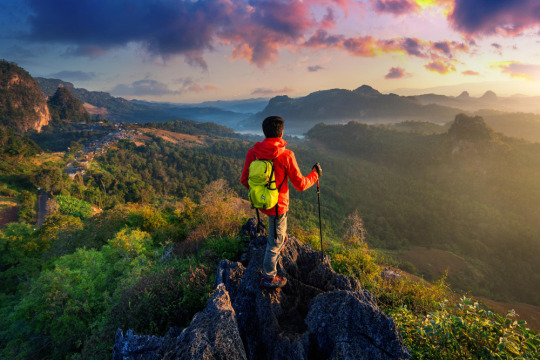
Greetings from North-East India, a region renowned for its breathtaking scenery, abundant cultural legacy, and unmatched variety. This area, which is tucked away in the Eastern Himalayan jungle, is a veritable gold mine of stunning scenery, colourful celebrations, and gracious people.
North East India comprises eight states—Arunachal Pradesh, Assam, Manipur, Meghalaya, Mizoram, Nagaland, and Tripura (commonly known as the “Seven Sisters”). Travellers seeking adventure, peace, and real cultural experiences will find that North East India, with its snow-capped peaks and lush tea gardens in Assam, offers a fully immersive experience.
Northeast India is renowned for its biodiversity. It is one of India’s two hotspots for biodiversity. This region is home to half of all known floral species in India and the abundance of orchids in the area’s woodlands is a significant feature. Eighty-six orchid species, or 70% of India’s total orchid flora, are found in the Northeast. Numerous biospheres, national parks, and animal sanctuaries have been established in the area to protect its biodiversity.
Come along with us as we venture into the unknown and unearth Northeast India’s amazing green treasures.
Kaziranga National Park, Assam
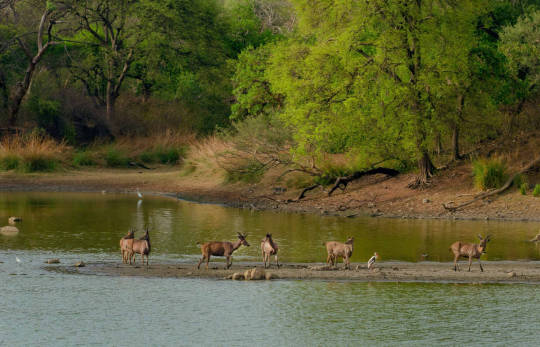
Welcome to Kaziranga National Park, a gem of wildlife preservation tucked away in the northeastern Indian state of Assam. This national treasure flows through the powerful Brahmaputra River and has rich flora spread throughout its floodplains. It is home to the biggest number of one-horned rhinos on Earth.
It has been designated a UNESCO World Heritage Site since 1985 and appeals to both nature enthusiasts and curious travellers.
Take daytime or nighttime safaris to get a look at the magnificent Asiatic elephants, Royal Bengal Tigers, wild water buffalo, and leopards that live in this sanctuary. Having one of the biggest tiger populations in the world, it is also a certified tiger reserve. Guided tours guarantee that tourists get up close and personal with the rich biodiversity while ensuring environmental sustainability. Trekking is prohibited to protect the park’s fragile ecosystem.
Learn More...
0 notes
Text
Kokborok Day — Celebrating the Language of Tripura

On 19th January, 1979, the state of Tripura declared Kokborok as it is official language. Every year, 19th January is observed as ‘Kokborok Day’ to commemorate the recognition. A range of activities are held on this day including cultural programmes and literary activities.
Kokborok is one of the ancient languages in the Northeastern region of India. The language can be traced back to the 1st Century AD in a book called Rajratnakar, a chronicle of Tripuri kings. Since then the language has seen a revival.
Since the 1980s, the language has been taught in schools of Tripura from the primary level to the higher secondary stage. A certificate course in Kokborok was also introduced at Tripura University in 1994, and subsequently, a post-graduate diploma followed in 2001. Kokborok was introduced in the Bachelor of Arts (BA) degree in the colleges affiliated with Tripura University from the year 2012, and a Masters of Arts (MA) degree in Kokborok was started by Tripura University from the year 2015.
Attempts have been made to include the language as one of the recognized official languages of India as per the 8th schedule of the Constitution.
In this article, we would like to celebrate Tripura, by looking at some of the amazing facts of the state.
It is the 5th Largest Tea Producer of India
There are 21 tea processing factories and 2500 small tea growers producing about 8.66 million kg of tea every year in Tripura, making it the fifth largest tea-producing state in India.
2. It has one of the highest literacy rates in India
Tripura has the fourth highest literacy rate in India, with 87.75% of the population being literate according to the 2011 census report. However, a state government survey puts the number at 94.65%. This enormous success has been credited to the works of state government, local NGOs and gram panchayats.
3. Home to Bamboos
Tripura has 21 species of Bamboo out of 130 species of Bamboo available in India, representing 28% of the country’s bamboo stock. It is used for building houses, handicrafts and as raw material for the Panchgram paper mill.

Unakoti, aka Angkor Wat of the North-East, is a series of rock carvings, presenting the figures of various gods and goddesses. Unakoti literally means “one less one crore” or “koti” in Hindi. It was categorized as a UNESCO World Heritage Site tentative list in 2022.
5. Architectural Brilliance of Tripura
Unakoti is not the only marvel of architecture in Tripura. The state also has some brilliant structures like Neer Mahal (The Largest Water Palace in India), Matabari or Tripura Sundari (Shaktipeeth) Temple (500 Years Old Temple), and Ujjayanta Palace (built by Maharaja Radha Kishore Manikya in 1901).
Thank you for reading this article. Make sure to share this with all your friends and family members to give them a taste of the brilliance that resides in Tripura.
#filaantro#crowdfunding#raise funds#fundraising#nonprofits#charity#education#donate#donations#volunteering#Kokborok Day
1 note
·
View note